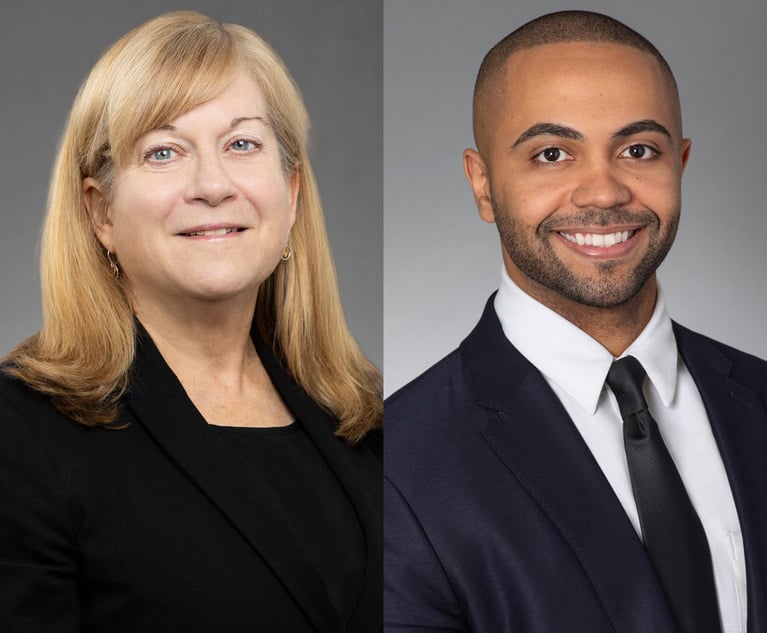It's Time to Strengthen Railway Safety Laws for Passengers, Crews
Nearly everyone agrees that high-speed passenger rail is a great idea. As Brightline high-speed rail makes its debut in South Florida, it's time to focus more attention on passengers and crews.
January 24, 2018 at 04:50 PM
5 minute read

Nearly everyone agrees that high-speed passenger rail is a great idea. As Brightline high-speed rail makes its debut in South Florida, it's time to focus more attention on passengers and crews.
Faster rail service saves fossil fuel, speeds travel between cities, lessens stress, aids productivity, makes rail more attractive, and has the potential to take up to 3 million cars off South Florida's clogged roads.
Yet we ignore the human cost at our peril. Railroads are putting profits before people, and the evidence abounds. Crews are growing sparser and more fatigued. The rail industry, abetted by its powerful lobbies, is dragging its feet on installing critical safety control systems. Congress is saddling big medical costs on passengers and crew injured through no fault of their own.
As 2018 dawns with talk of infrastructure improvements, remember the Dec. 18 Amtrak derailment near Tacoma, Washington. The engine and six cars barreling at 78 mph—50 mph above the speed limit—jumped the tracks and crashed down an embankment onto a highway, killing three and injuring 100.
Or take the Philadelphia crash in May 2015. That Amtrak Washington-to-New York train was traveling at 102 mph in a 50 mph zone when it rounded a bend and derailed. Of the 238 passengers and five crew, eight were killed and 200 injured, 11 critically.
Both were avoidable, and human error played a big part. In Washington, the engineer may not have known the territory. In Philadelphia, the engineer was indicted for negligent manslaughter.
The real disgrace, however, is the lack of positive train control (PTC), the life-saving system that automatically prevents train-to-train collisions and derailments from excessive speed.
The technology has been around for a generation. These systems are mandated by the Rail System Improvement Act of 2008, signed into law just one month after the Sept. 12, 2008, Chatsworth, California, collision between a Metrolink passenger train and a Union Pacific freight train, killing 25 and injuring 135. The passenger engineer, distracted by text messages, failed to heed a red light to slow down.
The act required PTC systems on most railroad networks by the end of 2015. That October, Congress, under pressure from railway lobbies, extended the deadline to the end of 2018. In some cases, that deadline is the end of 2020.
Yet today, nearly 10 years after Chatsworth and the act's passage—and nearly three years after Philadelphia—only 24 percent of railroads have PTC.
The act also limits the number of hours freight crews work every month, and requires the Department of Transportation to determine work hour limits for passenger crews.
Crew fatigue is a big issue, as crews grow thinner. Most Amtrak trains run with a single engineer in the cab. The railroad industry has reduced freight crews to two on the rails and one in the yard.
Big accidents, of course, produce lawsuits. Here, Congress has simplified things and capped at $295 million the total allowable awards from a single accident, regardless of scale. While this number sounds large—it us up from the original $200 million limit in the 1997 Amtrak Reform and Accountability Act—that very cap after the Philadelphia tragedy covered only 30 to 40 percent of the medical costs, pain and suffering, and loss of income by the injured.
The victims were on the hook for the rest. With the recent signing of that tax bill, will the Washington derailment victims fare any better?
It is true that, in general, rail is a safe, convenient way to travel. We are better off as a nation, and society, using trains more, not less.
Yet will we learn the lessons of Washington, Philadelphia, Chatsworth? The pressure is on for high-speed rail, as we fall behind other nations in passenger rail and so many other aspects of our infrastructure. In China, Japan, Germany, Italy, Belgium, France and Spain, 200-mph trains—some with top speeds above 300 mph—are common, traveling on new, immaculately maintained tracks.
Here in the United States, demand for high-speed rail far outpaces investment. Amtrak alone reports a backlog of $38 billion of deferred capital investments, risking expansion, reliability and even lives.
High speed need not equal high drama and increased human risk. The railroad industry is working to dilute longstanding protections—including the Federal Employers' Liability Act (FELA), passed in 1908 under President Teddy Roosevelt to protect and compensate railroad workers injured on the job.
It is as urgent as ever to strengthen protections for those people who make our trains run and the rest of us who entrust the railways and their workers with safe travels.
Howard Spier is a partner at the Miami law firm Rossman, Baumberger, Reboso & Spier and has represented railway workers since 1981. He is a director and former president of the Academy of Railway Labor Attorneys.
This content has been archived. It is available through our partners, LexisNexis® and Bloomberg Law.
To view this content, please continue to their sites.
Not a Lexis Subscriber?
Subscribe Now
Not a Bloomberg Law Subscriber?
Subscribe Now
NOT FOR REPRINT
© 2025 ALM Global, LLC, All Rights Reserved. Request academic re-use from www.copyright.com. All other uses, submit a request to [email protected]. For more information visit Asset & Logo Licensing.
You Might Like
View All

As a New Year Dawns, the Value of Florida’s Revised Mediation Laws Comes Into Greater Focus
4 minute read
Data Breaches, Increased Regulatory Risk and Florida’s New Digital Bill of Rights
7 minute read
Navigating Florida's Products Liability Law: Defective Products, Warnings and the Pursuit of Justice
6 minute readTrending Stories
Who Got The Work
Michael G. Bongiorno, Andrew Scott Dulberg and Elizabeth E. Driscoll from Wilmer Cutler Pickering Hale and Dorr have stepped in to represent Symbotic Inc., an A.I.-enabled technology platform that focuses on increasing supply chain efficiency, and other defendants in a pending shareholder derivative lawsuit. The case, filed Oct. 2 in Massachusetts District Court by the Brown Law Firm on behalf of Stephen Austen, accuses certain officers and directors of misleading investors in regard to Symbotic's potential for margin growth by failing to disclose that the company was not equipped to timely deploy its systems or manage expenses through project delays. The case, assigned to U.S. District Judge Nathaniel M. Gorton, is 1:24-cv-12522, Austen v. Cohen et al.
Who Got The Work
Edmund Polubinski and Marie Killmond of Davis Polk & Wardwell have entered appearances for data platform software development company MongoDB and other defendants in a pending shareholder derivative lawsuit. The action, filed Oct. 7 in New York Southern District Court by the Brown Law Firm, accuses the company's directors and/or officers of falsely expressing confidence in the company’s restructuring of its sales incentive plan and downplaying the severity of decreases in its upfront commitments. The case is 1:24-cv-07594, Roy v. Ittycheria et al.
Who Got The Work
Amy O. Bruchs and Kurt F. Ellison of Michael Best & Friedrich have entered appearances for Epic Systems Corp. in a pending employment discrimination lawsuit. The suit was filed Sept. 7 in Wisconsin Western District Court by Levine Eisberner LLC and Siri & Glimstad on behalf of a project manager who claims that he was wrongfully terminated after applying for a religious exemption to the defendant's COVID-19 vaccine mandate. The case, assigned to U.S. Magistrate Judge Anita Marie Boor, is 3:24-cv-00630, Secker, Nathan v. Epic Systems Corporation.
Who Got The Work
David X. Sullivan, Thomas J. Finn and Gregory A. Hall from McCarter & English have entered appearances for Sunrun Installation Services in a pending civil rights lawsuit. The complaint was filed Sept. 4 in Connecticut District Court by attorney Robert M. Berke on behalf of former employee George Edward Steins, who was arrested and charged with employing an unregistered home improvement salesperson. The complaint alleges that had Sunrun informed the Connecticut Department of Consumer Protection that the plaintiff's employment had ended in 2017 and that he no longer held Sunrun's home improvement contractor license, he would not have been hit with charges, which were dismissed in May 2024. The case, assigned to U.S. District Judge Jeffrey A. Meyer, is 3:24-cv-01423, Steins v. Sunrun, Inc. et al.
Who Got The Work
Greenberg Traurig shareholder Joshua L. Raskin has entered an appearance for boohoo.com UK Ltd. in a pending patent infringement lawsuit. The suit, filed Sept. 3 in Texas Eastern District Court by Rozier Hardt McDonough on behalf of Alto Dynamics, asserts five patents related to an online shopping platform. The case, assigned to U.S. District Judge Rodney Gilstrap, is 2:24-cv-00719, Alto Dynamics, LLC v. boohoo.com UK Limited.
Featured Firms
Law Offices of Gary Martin Hays & Associates, P.C.
(470) 294-1674
Law Offices of Mark E. Salomone
(857) 444-6468
Smith & Hassler
(713) 739-1250






